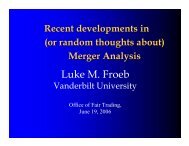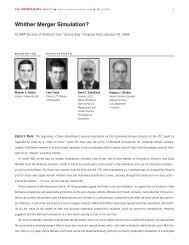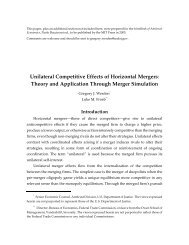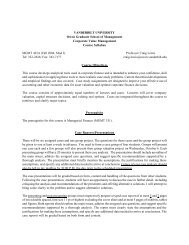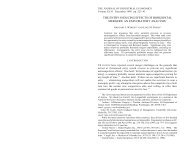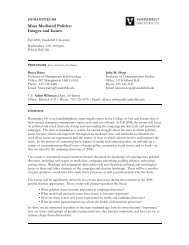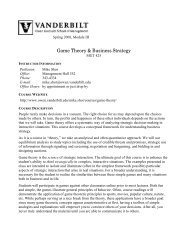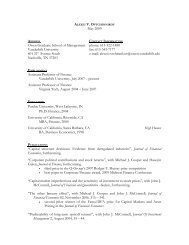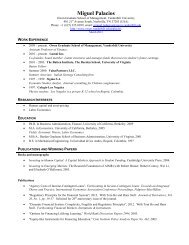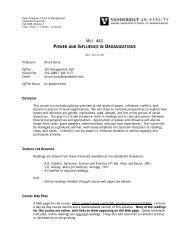Pass-Through Rates and the Price Effects of Mergers - Vanderbilt ...
Pass-Through Rates and the Price Effects of Mergers - Vanderbilt ...
Pass-Through Rates and the Price Effects of Mergers - Vanderbilt ...
Create successful ePaper yourself
Turn your PDF publications into a flip-book with our unique Google optimized e-Paper software.
<strong>Pass</strong>-<strong>Through</strong> <strong>Rates</strong> <strong>and</strong> <strong>the</strong><br />
<strong>Price</strong> <strong>Effects</strong> <strong>of</strong> <strong>Mergers</strong><br />
Luke Froeb ∗ <strong>and</strong> Steven Tschantz †<br />
V<strong>and</strong>erbilt University<br />
Nashville, TN 37203<br />
Gregory J. Werden ‡<br />
U.S. Department <strong>of</strong> Justice<br />
Washington, DC 20530<br />
October 6, 2003<br />
Abstract<br />
We investigate <strong>the</strong> relationship in Bertr<strong>and</strong> oligopoly between <strong>the</strong><br />
price effects <strong>of</strong> mergers absent synergies <strong>and</strong> <strong>the</strong> rates at which merger<br />
synergies are passed through to consumers in <strong>the</strong> form <strong>of</strong> lower prices.<br />
We find that <strong>the</strong> dem<strong>and</strong> conditions that cause a merger to result in<br />
large price increases absent synergies also cause <strong>the</strong> pass-through rate<br />
to be high. The low estimated pass-through rate <strong>and</strong> <strong>the</strong> relatively<br />
large predicted merger effect, thus, likely were inconsistent in an important<br />
US merger case.<br />
JEL Classification: D43 - Oligopoly; L41 - Horizontal Anticompetitive<br />
Practices<br />
Keywords: pass-through; merger; efficiencies; antitrust<br />
∗ Owen Graduate School <strong>of</strong> Management, luke.froeb@v<strong>and</strong>erbilt.edu, corresponding author.<br />
After this paper was completed, Froeb was named Director <strong>of</strong> <strong>the</strong> Bureau <strong>of</strong> Economics,<br />
Federal Trade Commission. The views expressed here are those <strong>of</strong> <strong>the</strong> authors<br />
<strong>and</strong> not those <strong>of</strong> <strong>the</strong> FTC or its commissioners.<br />
† Department <strong>of</strong> Ma<strong>the</strong>matics, tschantz@math.v<strong>and</strong>erbilt.edu<br />
‡ gregory.werden@usdoj.gov. The views expressed in this paper are not purported to<br />
represent those <strong>of</strong> <strong>the</strong> U.S. Department <strong>of</strong> Justice.
1 Introduction<br />
In static Bertr<strong>and</strong> oligopoly, we investigate <strong>the</strong> link between price increases<br />
from mergers absent synergies <strong>and</strong> <strong>the</strong> pass through to consumers <strong>of</strong> marginal<br />
cost changes associated with merger synergies. Our investigation is motivated<br />
by US court decisions, <strong>and</strong> enforcement policies in o<strong>the</strong>r jurisdictions,<br />
holding that synergies are relevant to <strong>the</strong> legality <strong>of</strong> a merger only to <strong>the</strong> extent<br />
that <strong>the</strong>y are passed on to consumers in <strong>the</strong> form <strong>of</strong> lower prices. In <strong>the</strong><br />
Staples–Office Depot merger case, for example, <strong>the</strong> court cited low estimated<br />
pass-through rates as an important reason that <strong>the</strong> claimed efficiencies did<br />
not outweigh <strong>the</strong> anticompetitive effects <strong>of</strong> <strong>the</strong> merger.<br />
We apply <strong>the</strong> term “merger effects” to <strong>the</strong> prices increases from a merger<br />
<strong>and</strong> model <strong>the</strong>m as <strong>the</strong> difference between <strong>the</strong> non-cooperative equilibrium<br />
in which <strong>the</strong> merged products are priced independently, <strong>and</strong> <strong>the</strong> noncooperative<br />
equilibrium in which <strong>the</strong>y are priced jointly. In our terminology,<br />
“net” merger effects include impacts <strong>of</strong> synergies on prices, while “gross”<br />
merger effects do not. Differences between net <strong>and</strong> gross merger effects are<br />
<strong>the</strong> “pass-through effects” <strong>of</strong> merger synergies. They are modelled as <strong>the</strong><br />
difference between <strong>the</strong> post-merger equilibrium without synergies <strong>and</strong> <strong>the</strong><br />
post-merger equilibrium with <strong>the</strong>m.<br />
We derive expressions for <strong>the</strong> net <strong>and</strong> gross merger effects by applying<br />
<strong>the</strong> first step in Newton’s method at <strong>the</strong> pre-merger prices. This provides<br />
an estimator <strong>of</strong> merger effects using only information potentially available<br />
in <strong>the</strong> observed pre-merger equilibrium. Examination <strong>of</strong> this estimator indicates<br />
that gross merger effects <strong>and</strong> pass-through effects are closely related.<br />
Both are determined largely by <strong>the</strong> degree <strong>of</strong> pr<strong>of</strong>it (dem<strong>and</strong>) concavity. In<br />
particular, holding first derivatives (e.g., dem<strong>and</strong> elasticities) constant, sec-<br />
1
ond derivatives (i.e., dem<strong>and</strong> concavity) determine both gross merger effects<br />
<strong>and</strong> pass-through.<br />
In <strong>the</strong> context <strong>of</strong> two major US merger cases, we demonstrate <strong>the</strong> practical<br />
importance <strong>of</strong> <strong>the</strong> association <strong>of</strong> high pass-through rates with large<br />
merger effects. The proposed WorldCom-Sprint merger illustrates that both<br />
pass-through <strong>and</strong> gross merger effects vary greatly with differing assumptions<br />
about <strong>the</strong> form <strong>of</strong> dem<strong>and</strong>. The proposed Staples–Office Depot merger<br />
illustrates that price increase predictions <strong>and</strong> pass through predictions each<br />
<strong>of</strong>fer a check on <strong>the</strong> o<strong>the</strong>r. We find a likely inconsistency in <strong>the</strong> estimates<br />
made <strong>the</strong> experts testifying for <strong>the</strong> Federal Trade Commission.<br />
2 Merger <strong>Effects</strong> with Assumed Dem<strong>and</strong> Forms<br />
2.1 Merger <strong>Effects</strong> in Bertr<strong>and</strong> Industries<br />
Consumers dem<strong>and</strong> quantities given by <strong>the</strong> vector q = {q i } as a function<br />
<strong>of</strong> <strong>the</strong> price vector p = {p i }, i = 1, . . . , n. Product i is supplied at cost c i<br />
which is a function <strong>of</strong> just q i . Pr<strong>of</strong>it from this product is<br />
π i = p i q i − c i . (1)<br />
These n products are <strong>the</strong> merging products <strong>and</strong> all competing products with<br />
prices that react to changes in <strong>the</strong> prices <strong>of</strong> <strong>the</strong> merging products.<br />
If each product is controlled by a different firm, maximizing <strong>the</strong> pr<strong>of</strong>it<br />
from just its product, <strong>the</strong> n first-order conditions for a Nash equilibrium are<br />
0 = ∂π i<br />
∂p i<br />
= q i + (p i − mc i ) ∂q i<br />
∂p i<br />
, (2)<br />
where<br />
mc i = dc i<br />
dq i<br />
(3)<br />
2
is <strong>the</strong> marginal cost <strong>of</strong> product i. We do not assume that marginal costs are<br />
constant, although this is <strong>of</strong>ten done in applied work. The effect <strong>of</strong> p j on q i ,<br />
with o<strong>the</strong>r prices held constant, is usually expressed in terms <strong>of</strong> elasticities:<br />
ɛ ij = p j<br />
q i<br />
∂q i<br />
∂p j<br />
. (4)<br />
The first-order conditions imply <strong>the</strong> familiar relation between price-cost margins<br />
<strong>and</strong> own-price dem<strong>and</strong> elasticities:<br />
p i − mc i<br />
p i<br />
= − 1<br />
ɛ ii<br />
. (5)<br />
When several products are controlled by <strong>the</strong> same firm, <strong>the</strong> dem<strong>and</strong><br />
interactions among its jointly owned products are internalized. If a single<br />
firm controls products 1 <strong>and</strong> 2, its first-order conditions are<br />
<strong>and</strong><br />
0 = ∂(π 1 + π 2 )<br />
∂p 1<br />
= q 1 + (p 1 − mc 1 ) ∂q 1<br />
∂p 1<br />
+ (p 2 − mc 2 ) ∂q 2<br />
∂p 1<br />
(6)<br />
0 = ∂(π 1 + π 2 )<br />
∂p 2<br />
= q 2 + (p 1 − mc 1 ) ∂q 1<br />
∂p 2<br />
+ (p 2 − mc 2 ) ∂q 2<br />
∂p 2<br />
. (7)<br />
These conditions lead to different equilibrium pricing than equation 2. In<br />
terms <strong>of</strong> <strong>the</strong> US Horizontal Merger Guidelines (1992), <strong>the</strong> difference between<br />
<strong>the</strong>se two equilibria is <strong>the</strong> “unilateral” effect <strong>of</strong> <strong>the</strong> merger between sellers<br />
<strong>of</strong> products 1 <strong>and</strong> 2 in Bertr<strong>and</strong> oligopoly.<br />
2.2 Predicting Gross Merger <strong>Effects</strong><br />
To predict <strong>the</strong> gross merger effects from differentiated products mergers,<br />
economists commonly assume a particular functional form for dem<strong>and</strong> <strong>and</strong><br />
estimate dem<strong>and</strong> elasticities. Marginal costs are recovered from <strong>the</strong> firstorder<br />
conditions at <strong>the</strong> pre-merger equilibrium (e.g., equation 5), <strong>and</strong> <strong>the</strong><br />
gross merger effects are computed by solving <strong>the</strong> post-merger first-order conditions<br />
(e.g., equations 6 <strong>and</strong> 7), assuming <strong>the</strong> same or a different functional<br />
3
form for dem<strong>and</strong> as that used to estimate <strong>the</strong> dem<strong>and</strong> elasticities.<br />
The<br />
foregoing process, termed “merger simulation,” is described by Werden <strong>and</strong><br />
Froeb (1996) <strong>and</strong> Crooke et al. (1999). Nevo (2000), Hausman et al. (1994),<br />
Hausman <strong>and</strong> Leonard (1997), <strong>and</strong> Werden (2000) apply <strong>the</strong> technique to<br />
particular mergers.<br />
The simplest form <strong>of</strong> merger simulation employs a constant-elasticity approximation<br />
to an unknown dem<strong>and</strong> curve (e.g., Shapiro, 1996). Using an<br />
estimate <strong>of</strong> <strong>the</strong> elasticity matrix at <strong>the</strong> pre-merger equilibrium, it is straightforward<br />
to compute post-merger prices. The constant-elasticity specification<br />
makes it unnecessary to have any information about non-merging products,<br />
as <strong>the</strong>ir prices do not change in response to <strong>the</strong> merger. However, if dem<strong>and</strong><br />
becomes more elastic as price increases, Crooke et al. (1999) show<br />
this approach can dramatically over-estimate merger effects.<br />
P<br />
22<br />
20<br />
200%<br />
18<br />
16<br />
14<br />
100%<br />
12<br />
10<br />
50%<br />
25%<br />
20 40 60 80 100<br />
Q<br />
Figure 1: Four Constant-<strong>Pass</strong>-<strong>Through</strong>-Rate Dem<strong>and</strong> Curves Plotted between<br />
<strong>the</strong> Competitive <strong>and</strong> Monopoly <strong>Price</strong>s<br />
4
Figure 1 illustrates why an erroneous assumption as to <strong>the</strong> functional<br />
form <strong>of</strong> dem<strong>and</strong> can lead to a very large prediction error.<br />
It plots four<br />
dem<strong>and</strong> curves for a single-product industry, all defined by <strong>the</strong> functions<br />
⎧<br />
⎪⎨ (a − bp) θ/(1−θ) θ < 1<br />
q(p) = a exp(−bp) θ = 1<br />
⎪⎩<br />
(a + bp) θ/(1−θ) θ > 1.<br />
These dem<strong>and</strong> curves exhibit a constant pass-through rate, θ = ∂p/∂∆mc,<br />
where ∆mc is change in marginal cost resulting from merger synergies. By<br />
construction, <strong>the</strong> four dem<strong>and</strong> curves share <strong>the</strong> same price, quantity, <strong>and</strong><br />
elasticity (−2) at a single point, which we make <strong>the</strong> competitive equilibrium<br />
by assuming a constant marginal cost equal to that price. Figure 1 plots<br />
<strong>the</strong>se dem<strong>and</strong> curves between <strong>the</strong> common competitive equilibrium <strong>the</strong> four<br />
different monopoly equilibria. The differing concavities <strong>of</strong> <strong>the</strong> four dem<strong>and</strong><br />
curves result in substantially different monopoly prices. The top dem<strong>and</strong><br />
curve, associated with a 200% pass-through rate, yields a price–marginal cost<br />
margin at <strong>the</strong> monopoly price nearly ten times <strong>the</strong> margin with <strong>the</strong> bottom<br />
dem<strong>and</strong> curve, associated with a 25% pass-through rate. To foreshadow <strong>the</strong><br />
main result <strong>of</strong> <strong>the</strong> paper, dem<strong>and</strong> concavity associated with higher monopoly<br />
prices is also associated with higher pass-through rates.<br />
2.3 Newton’s Method for Computing<br />
Post-Merger Equilibrium<br />
To compute equilibrium in industries with various ownership structures, we<br />
imagine that <strong>the</strong> pricing <strong>of</strong> each product is controlled by a single agent<br />
that may share in <strong>the</strong> pr<strong>of</strong>its <strong>of</strong> o<strong>the</strong>r products. This heuristic allows us to<br />
characterize different kinds <strong>of</strong> equilibria, including a pre-merger equilibrium<br />
in which all prices are set independently, <strong>and</strong> a post-merger equilibrium in<br />
which <strong>the</strong> merged firm maximizes <strong>the</strong> sum <strong>of</strong> pr<strong>of</strong>its on its jointly owned<br />
5
products.<br />
To make this notion precise, we construct <strong>the</strong> “ownership-structure matrix,”<br />
W = {w ij }, with w ij indicating <strong>the</strong> share <strong>of</strong> pr<strong>of</strong>its from product j<br />
received by agent i setting <strong>the</strong> price <strong>of</strong> product i. Agent i thus maximizes<br />
Ω i = ∑ j<br />
w ij π j . (8)<br />
The pre-merger ownership structure, for example, may have W equal to <strong>the</strong><br />
identity matrix, while a post-merger ownership structure may have W equal<br />
to <strong>the</strong> identity matrix except for two <strong>of</strong>f-diagonal entries. Both structures<br />
are represented by <strong>the</strong> matrix<br />
⎛<br />
1 r<br />
⎞<br />
0<br />
W = ⎝ r 1 0 ⎠ . (9)<br />
0 0 1<br />
Setting r = 0 reflects <strong>the</strong> pre-merger structure, while setting r = 1 reflects<br />
<strong>the</strong> post-merger structure. The formulation <strong>of</strong> <strong>the</strong> model in terms <strong>of</strong> <strong>the</strong> W<br />
matrix also can be used to incorporate partial ownership before or after a<br />
merger, as analyzed by O’Brien <strong>and</strong> Salop (2000).<br />
In this general formulation, <strong>the</strong> n first-order conditions are<br />
0 = ∂Ω i<br />
∂p i<br />
= ∑ j<br />
w ij<br />
∂π j<br />
∂p i<br />
= w ii q i + ∑ j<br />
w ij (p j − mc j ) ∂q j<br />
∂p i<br />
. (10)<br />
These first-order conditions apply both pre- <strong>and</strong> post-merger, using <strong>the</strong> relevant<br />
pre- <strong>and</strong> post-merger values for <strong>the</strong> w ij <strong>and</strong> mc j .<br />
To develop an expression for <strong>the</strong> net merger effect, we review how one<br />
uses Newton’s method to find a Nash equilibrium satisfying <strong>the</strong>se first-order<br />
conditions. Let z i = ∂Ω i /∂p i , <strong>and</strong> let z = {z i } be <strong>the</strong> vector <strong>of</strong> <strong>the</strong>se<br />
derivatives expressed as functions <strong>of</strong> p. To solve for simultaneous zeros <strong>of</strong> z,<br />
we take an initial estimate p (0) <strong>and</strong> successively refine <strong>the</strong> estimate by <strong>the</strong><br />
6
p (1) , p (2) , p (3) , . . . , generated by <strong>the</strong> rule<br />
p (k+1) = p (k) − A −1 z (k) , (11)<br />
where z (k)<br />
A = {a ij },<br />
= z(p (k) ) is <strong>the</strong> value <strong>of</strong> z at <strong>the</strong> latest approximation, <strong>and</strong><br />
a ij = ∂z i<br />
∂p j<br />
= w ii<br />
∂q i<br />
∂p j<br />
+ w ij<br />
∂q j<br />
∂p i<br />
+ ∑ k<br />
w ik (p k − mc k ) ∂2 q k<br />
∂p j ∂p i<br />
, (12)<br />
is also evaluated at p (k) . The A matrix, which indicates <strong>the</strong> slopes <strong>of</strong> <strong>the</strong><br />
derivatives <strong>of</strong> <strong>the</strong> pr<strong>of</strong>it functions, also may be written<br />
A = ∂z<br />
∂p . (13)<br />
For notational simplicity, we suppress <strong>the</strong> fact that A is a function <strong>of</strong> prices<br />
<strong>and</strong> is affected by merger through both W <strong>and</strong> <strong>the</strong> marginal costs.<br />
Newton’s method takes a first-order approximation to z at p (k) ,<br />
z ≈ z (k) + ∂z (<br />
p − p (k)) , (14)<br />
∂p<br />
<strong>and</strong> finds <strong>the</strong> value <strong>of</strong> p that sets this approximation equal to zero. To apply<br />
Newton’s method, it is necessary to specify an initial solution p (0) , <strong>and</strong><br />
<strong>the</strong> natural choice in merger analysis is <strong>the</strong> pre-merger equilibrium. Taking<br />
z (0) to be <strong>the</strong> first-order conditions evaluated with <strong>the</strong> post-merger ownership<br />
matrix at <strong>the</strong> pre-merger equilibrium prices, <strong>the</strong> first step in applying<br />
Newton’s method is<br />
p (1) = p (0) − A −1 z (0) . (15)<br />
Solving equation 15 requires evaluation <strong>of</strong> <strong>the</strong> second derivatives <strong>of</strong> q, as<br />
<strong>the</strong>y appear in A. These second derivatives determine <strong>the</strong> sharpness <strong>of</strong> <strong>the</strong><br />
peaks in <strong>the</strong> merged firm’s pr<strong>of</strong>it function or, put ano<strong>the</strong>r way, how much a<br />
small deviation from optimal pricing reduces pr<strong>of</strong>its.<br />
7
Equation 15 is a closed-form predictor <strong>of</strong> <strong>the</strong> net merger effects using only<br />
information potentially available at <strong>the</strong> observed pre-merger equilibrium. If<br />
nothing is known about <strong>the</strong> functional form <strong>of</strong> dem<strong>and</strong> function, equation<br />
15 <strong>of</strong>fers <strong>the</strong> best possible predictor <strong>of</strong> merger effects. If <strong>the</strong> post-merger<br />
first-order conditions are evaluated at <strong>the</strong> pre-merger marginal costs, i.e.,<br />
z (0) | mc pre, equation 15 yields <strong>the</strong> gross merger effect:<br />
∆p gme = −A −1 ( z (0) | mc pre<br />
)<br />
. (16)<br />
If <strong>the</strong> post-merger first-order conditions are evaluated at <strong>the</strong> marginal costs<br />
resulting from merger synergies, i.e., z (0) | mc post, equation 15 yields <strong>the</strong> net<br />
merger effect:<br />
( )<br />
∆p nme = −A −1 z (0) | mc post ≡ g(λ). (17)<br />
In both cases, A is evaluated at pre-merger prices <strong>and</strong> <strong>the</strong> same marginal<br />
costs as <strong>the</strong> first-order conditions.<br />
The net merger effects predictor can be used to compute confidence intervals.<br />
For example, if equation 17 is parameterized by a vector <strong>of</strong> estimable<br />
parameters λ, <strong>and</strong> ˆλ is an estimator <strong>of</strong> λ with a limiting normal distribution<br />
√ n(ˆλ − λ) → D N(0, Σ) <strong>the</strong>n √ n(g(ˆλ) − g(λ)) → D N(0, (∇g)Σ(∇g) ′ ),<br />
provided that g is continuously differentiable at λ. Such analytic expressions<br />
are useful for identifying factors that make confidence intervals large<br />
<strong>and</strong> may suggest estimation strategies to reduce sampling variance. The<br />
λ vector may include ∆mc i as well as dem<strong>and</strong> parameters, reflecting <strong>the</strong><br />
uncertainty <strong>of</strong> synergy estimates.<br />
If pr<strong>of</strong>its are a quadratic function <strong>of</strong> prices, e.g., dem<strong>and</strong> is linear <strong>and</strong><br />
marginal costs are constant, Newton’s method converges to <strong>the</strong> post-merger<br />
equilibrium in one step, so our one-step approximation gives <strong>the</strong> exact solution.<br />
For o<strong>the</strong>r dem<strong>and</strong> functions, <strong>the</strong> approximation could be refined by<br />
8
applying Newton’s method iteratively, but that would require information<br />
about <strong>the</strong> pr<strong>of</strong>it functions at prices away from <strong>the</strong> observed equilibrium.<br />
In merger simulation, <strong>the</strong> source <strong>of</strong> such “information” always has been an<br />
arbitrary assumption about <strong>the</strong> form <strong>of</strong> dem<strong>and</strong>. Without making such an<br />
assumption, equation 17 <strong>of</strong>fers <strong>the</strong> best possible approximation.<br />
An arbitrary assumption about <strong>the</strong> form <strong>of</strong> dem<strong>and</strong> can be avoided if<br />
that form can be determined empirically, along with <strong>the</strong> elasticities at <strong>the</strong><br />
pre-merger equilibrium. The available data (commonly two years <strong>of</strong> scanner<br />
data), however, normally are insufficiently informative: The range <strong>of</strong> price<br />
variation is ra<strong>the</strong>r limited, <strong>and</strong> <strong>the</strong> relationship between prices <strong>and</strong> quantities<br />
is noisy. Without better data than normally is available, distinguishing<br />
among even large differences in pass-through rates is apt to be infeasible.<br />
Consider <strong>the</strong> problem <strong>of</strong> empirically distinguishing among <strong>the</strong> four dem<strong>and</strong><br />
curves in Figure 1. If prices were observed only between 10 <strong>and</strong> 12, <strong>the</strong>se<br />
four dem<strong>and</strong> curves would be empirically indistinguishable unless <strong>the</strong> data<br />
fit extraordinarily well.<br />
3 <strong>Pass</strong>-<strong>Through</strong> <strong>Rates</strong> <strong>and</strong> Gross Merger <strong>Effects</strong><br />
3.1 <strong>Pass</strong>-<strong>Through</strong> <strong>Rates</strong><br />
We now consider how equilibrium pricing is affected by changes in costs, as<br />
examined in <strong>the</strong> context <strong>of</strong> monopoly by Bulow <strong>and</strong> Pleiderer (1983) <strong>and</strong><br />
in <strong>the</strong> context <strong>of</strong> differentiated products oligopoly by Anderson, De Palma,<br />
<strong>and</strong> Kreider (2001). We assume <strong>the</strong> effect <strong>of</strong> merger synergies on marginal<br />
cost is invariant to output, but we do not assume that marginal cost itself is<br />
invariant to output. In particular, merger synergies are assumed to shift <strong>the</strong><br />
marginal cost functions for <strong>the</strong> merged firm’s products by ∆mc = {∆mc i },<br />
with ∆mc i independent <strong>of</strong> q i , so each post-merger cost function equals that<br />
9
pre-merger plus q i ∆mc i .<br />
We assume <strong>the</strong> equilibrium prices are continuous <strong>and</strong> differentiable functions<br />
<strong>of</strong> ∆mc. Let<br />
{ }<br />
∂p<br />
∂∆mc = ∂pi<br />
∂∆mc j<br />
(18)<br />
be <strong>the</strong> matrix <strong>of</strong> rates at which marginal cost changes affect equilibrium<br />
prices, with <strong>the</strong> diagonal entries being <strong>the</strong> rates at which firms pass-through<br />
changes in <strong>the</strong>ir own marginal costs. Using <strong>the</strong> implicit function <strong>the</strong>orem<br />
<strong>and</strong> differentiating <strong>the</strong> first-order conditions for post-merger equilibrium<br />
(equation 10), it is straightforward to compute <strong>the</strong> rate at which changes in<br />
marginal cost are passed through to prices. The pass-through-rate matrix<br />
is<br />
where B = {b ij } <strong>and</strong><br />
( )<br />
∂p ∂z −1 ( ) ∂z<br />
∂∆mc = − = −A −1 B, (19)<br />
∂p ∂∆mc<br />
b ij =<br />
∂z i<br />
∂∆mc j<br />
= −w ij<br />
∂q j<br />
∂p i<br />
. (20)<br />
Hence, <strong>the</strong> impact <strong>of</strong> <strong>the</strong> marginal cost changes on equilibrium price changes<br />
is approximated to <strong>the</strong> first order by<br />
∆p spt ≈ −A −1 B∆mc, (21)<br />
where <strong>the</strong> subscript “spt” denotes “synergy pass through.” The pass-throughrate<br />
matrix (equation 19) indicates <strong>the</strong> extent to which marginal cost savings<br />
from a merger are passed through to consumer prices in <strong>the</strong> post-merger<br />
equilibrium <strong>and</strong> can be thought <strong>of</strong> as a predictor <strong>of</strong> <strong>the</strong> gross benefits <strong>of</strong> a<br />
merger (under a consumer-welfare st<strong>and</strong>ard, which ignores pr<strong>of</strong>it increases).<br />
Equation 19 is a function <strong>of</strong> both prices <strong>and</strong> <strong>the</strong> ownership structure,<br />
W, so pass-through rates in <strong>the</strong> pre-merger equilibrium differ from those in<br />
<strong>the</strong> post-merger equilibrium. The difference between pre- <strong>and</strong> post-merger<br />
10
pass-through rates is most important for <strong>the</strong> cross pass-through rates <strong>of</strong> <strong>the</strong><br />
products <strong>of</strong> <strong>the</strong> merging firms. This difference depends on <strong>the</strong> properties<br />
<strong>of</strong> particular dem<strong>and</strong> systems, <strong>and</strong> almost anything is possible. Cross passthrough<br />
rates may be positive pre merger but negative post merger, <strong>and</strong><br />
<strong>the</strong>y may be substantially greater pre merger even if positive both pre <strong>and</strong><br />
post merger.<br />
The W matrix incorporated in equation 21 through A <strong>and</strong> B reflects<br />
<strong>the</strong> post-merger ownership structure, while <strong>the</strong> derivatives in equation 21 are<br />
evaluated at pre-merger prices. Like <strong>the</strong> gross <strong>and</strong> net merger effect predictors,<br />
<strong>the</strong> synergy effect predictor incorporates only information potentially<br />
available at <strong>the</strong> observed pre-merger equilibrium.<br />
The second-order conditions for Bertr<strong>and</strong> equilibrium require that <strong>the</strong><br />
A matrix be negative definite, <strong>and</strong> this imposes restrictions on <strong>the</strong> passthrough<br />
matrix, −A −1 B.<br />
For example, in an industry characterized by<br />
single-product firms, −A −1 is positive definite <strong>and</strong> B is a diagonal matrix,<br />
with b ii = −∂q i /∂p i along <strong>the</strong> main diagonal. This implies that own passthrough<br />
rates are positive. And in a symmetric industry with single-product<br />
firms, all <strong>of</strong> <strong>the</strong> b ii are <strong>the</strong> same, so B is a scalar times <strong>the</strong> identity matrix,<br />
which implies that <strong>the</strong> pass-through matrix is positive definite.<br />
3.2 The Relationship Between <strong>Pass</strong>-<strong>Through</strong><br />
<strong>Rates</strong> <strong>and</strong> Merger <strong>Effects</strong><br />
Adding <strong>the</strong> gross merger effect <strong>of</strong> equation 16 <strong>and</strong> <strong>the</strong> synergy effect <strong>of</strong><br />
equation 21 yields <strong>the</strong> net merger effect:<br />
( )<br />
∆p gme + ∆p spt ≈ −A −1 z (0) | mc pre + B∆mc . (22)<br />
Because A is <strong>the</strong> matrix <strong>of</strong> derivatives with respect to prices <strong>of</strong> <strong>the</strong> vector <strong>of</strong><br />
first-order conditions for pr<strong>of</strong>it maximization, equation 22 clearly indicates<br />
11
<strong>the</strong> influence <strong>of</strong> dem<strong>and</strong> second derivatives, through A, on both <strong>the</strong> gross<br />
merger effect <strong>and</strong> <strong>the</strong> pass-through effect. The terms in <strong>the</strong> paren<strong>the</strong>ses in<br />
equation 22 include only first derivatives: z (0) | mc pre is <strong>the</strong> vector <strong>of</strong> firstorder<br />
conditions evaluated at <strong>the</strong> pre-merger marginal costs (equation 12),<br />
while B is <strong>the</strong> matrix <strong>of</strong> dem<strong>and</strong> partial derivatives multiplied by pr<strong>of</strong>it<br />
ownership shares (equation 20). Holding <strong>the</strong>se two terms constant, <strong>the</strong>re<br />
is a one-to-one relationship between gross merger effects <strong>and</strong> pass-through<br />
rates. This relationship is manifest in Figure 1 (<strong>and</strong> in Table 2 below).<br />
It is easy to underst<strong>and</strong> why <strong>the</strong> gross merger effects <strong>and</strong> pass-through<br />
rates both depend on dem<strong>and</strong> concavity. The first-order conditions characterizing<br />
equilibrium are <strong>the</strong> first derivatives <strong>of</strong> <strong>the</strong> pr<strong>of</strong>it functions. The<br />
extent to which equilibrium is displaced by a merger or marginal cost reduction<br />
thus depends on <strong>the</strong> derivatives <strong>of</strong> <strong>the</strong> first-order conditions, <strong>and</strong><br />
hence on concavity <strong>of</strong> <strong>the</strong> pr<strong>of</strong>it function, which in this model is determined<br />
by dem<strong>and</strong> concavity.<br />
Data relating to <strong>the</strong> ab<strong>and</strong>oned WorldCom-Sprint merger can be used<br />
to illustrate <strong>the</strong> relationship between merger effects <strong>and</strong> pass-through rates.<br />
Shares <strong>and</strong> estimated elasticities <strong>of</strong> dem<strong>and</strong> for residential long-distance service<br />
are taken from Hausman’s (2000) submission to <strong>the</strong> Federal Communications<br />
Commission in opposition to <strong>the</strong> merger. We assume a common<br />
pre-merger price <strong>of</strong> $0.07 per minute. AT&T was <strong>the</strong> largest carrier with<br />
63.4% <strong>of</strong> <strong>the</strong> domestic residential long-distance minutes, followed by World-<br />
Com with 16.4% <strong>and</strong> Sprint with 5.0%. We place all o<strong>the</strong>r firms in <strong>the</strong><br />
residual category, “Emerging,” treating <strong>the</strong>m as a single price-setting entity<br />
in <strong>the</strong> simulations below. This treatment imparts a slight upward bias<br />
to <strong>the</strong> simulated merger effects. Hausman’s estimated elasticity matrix is<br />
presented in Table 1. The columns relate to prices <strong>and</strong> <strong>the</strong> rows relate to<br />
12
quantities, so <strong>the</strong> figure in <strong>the</strong> third column <strong>of</strong> <strong>the</strong> first row is <strong>the</strong> elasticity<br />
<strong>of</strong> AT&T’s dem<strong>and</strong> with respect to Sprint’s price.<br />
Table 1: Estimated Elasticity Matrix for Residential Long Distance Carriers<br />
AT&T WorldCom Sprint Emerging<br />
AT&T −1.12 0.09 0.03 0.16<br />
WorldCom 0.50 −1.33 0.06 0.23<br />
Sprint 0.61 0.22 −1.81 0.30<br />
Emerging 0.47 0.12 0.04 −1.33<br />
Three different commonly used dem<strong>and</strong> systems—linear, AIDS (without<br />
income effects), <strong>and</strong> constant elasticity—are calibrated to <strong>the</strong> same premerger<br />
equilibrium, i.e., <strong>the</strong> same prices, quantities, <strong>and</strong> elasticities (see<br />
Crooke et al. (1999) for calibration details). Table 2 displays <strong>the</strong> resulting<br />
merger effects as well as <strong>the</strong> marginal pass-trough rates at <strong>the</strong> post-merger<br />
equilibrium. We suppose that all <strong>of</strong> <strong>the</strong> merger synergies accrue to <strong>the</strong><br />
Sprint product <strong>and</strong> examine <strong>the</strong> pass-through rates to <strong>the</strong> prices <strong>of</strong> all four<br />
products. These pass-through rates are not approximations; <strong>the</strong> assumption<br />
<strong>of</strong> specific dem<strong>and</strong> forms makes approximation unnecessary.<br />
Table 2: Gross Merger <strong>Effects</strong> <strong>and</strong> <strong>Pass</strong>-<strong>Through</strong> <strong>Rates</strong> for <strong>the</strong> WorldCom-<br />
Sprint Merger<br />
Dem<strong>and</strong> Merger Effect <strong>Pass</strong>-through Rate from Sprint Cost to<br />
Form %∆p W C+Sp AT&T WorldCom Sprint Emerging<br />
Linear 2.3 0.007 0.001 0.502 0.008<br />
AIDS 13.8 0.046 0.032 1.807 0.052<br />
Isoelastic 16.4 0.000 −0.343 3.838 0.000<br />
The striking feature <strong>of</strong> Table 2 is <strong>the</strong> difference across dem<strong>and</strong> systems<br />
in predicted gross merger effects <strong>and</strong> pass-through rates.<br />
With isoelastic<br />
13
dem<strong>and</strong>, both <strong>the</strong> merger effect <strong>and</strong> Sprint’s own pass-through rate (from<br />
Sprint’s marginal costs to Sprint’s price) are over seven times as large as<br />
<strong>the</strong>y are with linear dem<strong>and</strong>. Since all dem<strong>and</strong> systems have <strong>the</strong> same<br />
elasticities by construction, <strong>the</strong> differences across systems are due to <strong>the</strong><br />
different second derivatives.<br />
4 Compensating Marginal Cost Reductions<br />
While dem<strong>and</strong> second derivatives are important determinants <strong>of</strong> both merger<br />
<strong>and</strong> pass-through effects, Werden (1996) <strong>and</strong> Stenneck <strong>and</strong> Verboven (2001)<br />
have shown that <strong>the</strong> marginal cost reductions necessary to keep prices constant<br />
depend only on first derivatives, prices, <strong>and</strong> quantities. These “compensating<br />
marginal cost reductions” can be computed by setting <strong>the</strong> term<br />
in paren<strong>the</strong>ses in equation 22 to zero, <strong>and</strong> solving for ∆mc:<br />
∆mc comp = −B −1 z (0) | mc pre . (23)<br />
Compensating marginal cost reductions are robust with respect to different<br />
dem<strong>and</strong> forms, in that <strong>the</strong>y do not depend on <strong>the</strong> concavity <strong>of</strong> dem<strong>and</strong>.<br />
This is easily seen from <strong>the</strong> fact <strong>the</strong> matrix B <strong>and</strong> <strong>the</strong> vector z (0) contain<br />
only first-order terms. And since prices do not change, <strong>the</strong> non-merging<br />
firms’ first-order conditions remain at zero, so <strong>the</strong> elements <strong>of</strong> z (0) corresponding<br />
to <strong>the</strong> non-merging firms are zero. The matrix W, <strong>and</strong> thus <strong>the</strong><br />
matrix B, has a block-diagonal form, with <strong>the</strong> merging products forming<br />
a block. Because <strong>the</strong> inverse <strong>of</strong> B is also block diagonal, <strong>the</strong> compensating<br />
marginal cost reductions depend only on <strong>the</strong> elements corresponding<br />
to <strong>the</strong> merging products. Using Hausman’s estimated elasticities from <strong>the</strong><br />
WorldCom-Sprint merger, <strong>the</strong> compensating marginal cost reductions are<br />
19% for Sprint <strong>and</strong> 13% for WorldCom, measured as a percentage <strong>of</strong> <strong>the</strong>ir<br />
14
pre-merger marginal costs.<br />
When merger synergies exactly <strong>of</strong>fset <strong>the</strong> gross merger effects, <strong>the</strong> passthrough<br />
rates can be computed by dividing <strong>the</strong> gross merger effect, ∆p gme ,<br />
by <strong>the</strong> compensating marginal cost reductions, ∆mc comp . Thus, <strong>the</strong>re is a<br />
simple relationship between compensating marginal cost reductions, gross<br />
merger effects, <strong>and</strong> merging product dem<strong>and</strong> elasticities. This relationship<br />
allows a useful analysis <strong>of</strong> pass-through rates that does not depend on second<br />
derivatives <strong>of</strong> dem<strong>and</strong> <strong>and</strong> hence is not dependent on its functional form.<br />
5 <strong>Pass</strong> <strong>Through</strong> in Staples–Office Depot<br />
As discussed by Dalkir <strong>and</strong> Warren-Boulton (2004), in 1997 <strong>the</strong> Federal<br />
Trade Commission successfully challenged <strong>the</strong> merger <strong>of</strong> Staples <strong>and</strong> Office<br />
Depot, <strong>the</strong> two largest <strong>of</strong>fice supply superstore chains in <strong>the</strong> US. In opposing<br />
<strong>the</strong> merger, <strong>the</strong> FTC’s economic experts estimated that 85% <strong>of</strong> industrywide<br />
marginal cost reductions had been passed through to retail prices,<br />
while only 15% <strong>of</strong> firm-specific marginal cost reductions had been passed<br />
through (Ashenfelter et al., 1998). The court relied on <strong>the</strong> latter estimate<br />
in determining that synergies generated by <strong>the</strong> merger were insufficient to<br />
prevent price increases.<br />
As discussed by Ashenfelter et al. (2004) <strong>and</strong> Baker (1999), <strong>the</strong> FTC’s<br />
economic experts also used panel data to estimate <strong>the</strong> price effect <strong>of</strong> changing<br />
<strong>the</strong> number <strong>of</strong> <strong>of</strong>fice superstores, assuming no synergies. Public sources<br />
report only nationwide average price increase predictions for <strong>the</strong> merger,<br />
reflecting both cities in which <strong>the</strong> merging firms were <strong>the</strong> only <strong>of</strong>fice supply<br />
superstores <strong>and</strong> cities in which <strong>the</strong>re was a third superstore. Based <strong>the</strong><br />
reported estimates, we assume a predicted price increase <strong>of</strong> 7.5% for <strong>the</strong><br />
cities with just <strong>the</strong> merging firms.<br />
15
The analysis <strong>of</strong> <strong>the</strong> preceding section provides a check for <strong>the</strong> consistency<br />
<strong>of</strong> <strong>the</strong> estimated firm-specific pass-through rate with <strong>the</strong> predicted price increase.<br />
Assuming <strong>the</strong> merging firms were symmetric in all relevant respects,<br />
Werden (1996) shows that <strong>the</strong> compensating marginal cost reduction relative<br />
to pre-merger price, can be computed as<br />
∆mc<br />
p<br />
= − dm<br />
1 − d , (24)<br />
where m is <strong>the</strong> price-marginal cost margin <strong>and</strong> d is <strong>the</strong> diversion ratio from<br />
one superstore to ano<strong>the</strong>r, d = ɛ ij /ɛ ii . Rearranging <strong>the</strong> result at <strong>the</strong> end <strong>of</strong><br />
<strong>the</strong> preceding section, <strong>the</strong> implied compensating marginal cost reductions<br />
are given by <strong>the</strong> gross merger effect (7.5%) divided by <strong>the</strong> firm-specific passthrough<br />
rate (15%). This yields a compensating marginal cost reduction <strong>of</strong><br />
50% <strong>of</strong> price for both merging firms, so equation 24 implies d = 1/(1 + 2m).<br />
Symmetry also implies <strong>the</strong> aggregate elasticity <strong>of</strong> dem<strong>and</strong> for <strong>of</strong>fice superstores,<br />
ɛ, divided by <strong>the</strong> individual firm own-price elasticity, ɛ ii , equals<br />
1 − d. Since Betr<strong>and</strong> equilibrium implies ɛ ii = −1/m, <strong>the</strong> solution for d as<br />
a function <strong>of</strong> m implies ɛ = −2/(1 + 2m). To check for consistency, this<br />
relationship implied by <strong>the</strong> price-increase <strong>and</strong> pass-through rate predictions<br />
can be compared with what may have been known about margins <strong>and</strong> <strong>the</strong><br />
aggregate elasticity <strong>of</strong> <strong>of</strong>fice superstore dem<strong>and</strong>.<br />
We suspect that aggregate<br />
dem<strong>and</strong> for <strong>of</strong>fice supply superstores was known to be ra<strong>the</strong>r elastic<br />
because <strong>the</strong>re were many alternative sources for <strong>of</strong>fice supplies. If so, <strong>the</strong><br />
price-increase prediction was inconsistent with <strong>the</strong> pass-through prediction,<br />
since ɛ < −2 implies m < 0, which surely was not <strong>the</strong> case. This conclusion,<br />
however, depends on <strong>the</strong> assumption <strong>of</strong> Bertr<strong>and</strong> competition, <strong>and</strong> we do<br />
not know whe<strong>the</strong>r this is what <strong>the</strong> FTC had in mind.<br />
An additional check on <strong>the</strong> internal consistency <strong>of</strong> <strong>the</strong> predictions <strong>of</strong> <strong>the</strong><br />
FTC’s economists follows from Section 3.1. This check employs <strong>the</strong> 15%<br />
16
firm-specific pass-through rate estimated <strong>and</strong> <strong>the</strong> estimated industry-wide<br />
pass-through rate <strong>of</strong> 85%. In a symmetric Bertr<strong>and</strong> industry, <strong>the</strong> industrywide<br />
pass-through rate is <strong>the</strong> sum <strong>of</strong> <strong>the</strong> elements <strong>of</strong> any row in <strong>the</strong> passthrough<br />
matrix. Assuming symmetry <strong>and</strong> that both <strong>of</strong> <strong>the</strong> estimates from<br />
Ashenfelter et al. (1998) were correct, it is simple to compute <strong>the</strong> implied <strong>of</strong>fdiagonal,<br />
or cross, pass-through rates—those from <strong>the</strong> costs <strong>of</strong> one merging<br />
firm to <strong>the</strong> o<strong>the</strong>r merging firm’s price.<br />
In two-superstore cities, <strong>the</strong> cross pass-through rates in each row would<br />
have to be 70%, causing <strong>the</strong> pass-through matrix not to be positive definite,<br />
<strong>and</strong> causing <strong>the</strong> second-order conditions for Bertr<strong>and</strong> equilibrium not to be<br />
satisfied. Ano<strong>the</strong>r way to see this is to translate <strong>the</strong> cross pass-through rates<br />
into slopes <strong>of</strong> best-response functions. This translation is straightforward<br />
because <strong>the</strong> cross pass-through effect is just a response to a rival’s price<br />
change. The slopes <strong>of</strong> <strong>the</strong> two best-response functions are just <strong>the</strong> ratio <strong>of</strong><br />
<strong>the</strong> cross <strong>and</strong> own pass-through rates, which is 70/15. With <strong>the</strong>se slopes, <strong>the</strong><br />
best-response functions would not cross, <strong>and</strong> equilibrium would not exist.<br />
Finally, even if <strong>the</strong> estimated pass-through rates were correct <strong>and</strong> accurate<br />
in <strong>the</strong> Staples–Office Depot case, <strong>the</strong>y may have been misleading,<br />
because <strong>the</strong> merger would have caused <strong>the</strong> pass-through rates to change.<br />
The changes in prices resulting from <strong>the</strong> merger, <strong>and</strong> <strong>the</strong> changes in ownership<br />
that <strong>the</strong> merger bring about, both affect <strong>the</strong> pass-through rates. Postmerger<br />
pass-through rates could not have been estimated directly, but could<br />
have been constructed from <strong>the</strong> parameters <strong>of</strong> <strong>the</strong> firm-level pr<strong>of</strong>it functions.<br />
6 Discussion<br />
The net price effects <strong>of</strong> mergers is <strong>the</strong> touchstone for <strong>the</strong> legality <strong>of</strong> mergers<br />
under current law in <strong>the</strong> US <strong>and</strong> many o<strong>the</strong>r jurisdictions, <strong>and</strong> we present a<br />
17
igorous methodology for implementing that policy. We show that <strong>the</strong>re is a<br />
strong relationship between <strong>the</strong> gross consumer costs imposed by a merger,<br />
i.e., <strong>the</strong> increases in consumer prices absent synergies, <strong>and</strong> <strong>the</strong> gross consumer<br />
benefits derived from <strong>the</strong> merger, i.e., <strong>the</strong> pass through to consumer<br />
prices <strong>of</strong> marginal cost reductions from merger synergies. Holding constant<br />
<strong>the</strong> first-order conditions at <strong>the</strong> pre-merger equilibrium, higher-order properties<br />
that cause larger price increases absent synergies also cause merger<br />
synergies to be passed through at higher rates.<br />
The gross price effects <strong>and</strong> pass-through effects <strong>of</strong> mergers can be jointly<br />
estimated using <strong>the</strong> net merger predictor presented in equation 17. The<br />
second derivatives <strong>of</strong> <strong>the</strong> pr<strong>of</strong>it (dem<strong>and</strong>) function play a vital role in determining<br />
both effects, <strong>and</strong> <strong>the</strong> estimator <strong>of</strong> <strong>the</strong> net merger effect is crucially<br />
dependent on <strong>the</strong>m. As an alternative to estimating dem<strong>and</strong> second derivatives,<br />
one can compute <strong>the</strong> compensating marginal cost reductions necessary<br />
to <strong>of</strong>fset <strong>the</strong> merger price effects. These depend only on <strong>the</strong> first-order conditions<br />
at <strong>the</strong> pre-merger equilibrium, which in principle are observable. By<br />
comparing likely cost reductions with <strong>the</strong>se compensating marginal cost reductions,<br />
it generally is possible to determine whe<strong>the</strong>r prices are likely to<br />
rise or fall.<br />
The foregoing is predicated on <strong>the</strong> assumption <strong>of</strong> Bertr<strong>and</strong> competition,<br />
but similar results obtain with o<strong>the</strong>r Nash non-cooperative equilibria. The<br />
conditions characterizing such equilibria are first derivatives <strong>of</strong> <strong>the</strong> pr<strong>of</strong>it<br />
functions, so <strong>the</strong> displacement <strong>of</strong> equilibrium by ei<strong>the</strong>r merger or marginal<br />
cost reductions is determined by <strong>the</strong> concavity <strong>of</strong> <strong>the</strong> pr<strong>of</strong>it functions. In<br />
o<strong>the</strong>r models, however, pr<strong>of</strong>it concavity may not be controlled by <strong>the</strong> form<br />
<strong>of</strong> dem<strong>and</strong>. Tschantz, Crooke, <strong>and</strong> Froeb (2000) show that <strong>the</strong> distribution<br />
<strong>of</strong> costs is critical in a first- or second-price private-values auction model.<br />
18
Generalizations <strong>of</strong> <strong>the</strong> Bertr<strong>and</strong> model may affect pass through significantly.<br />
Froeb, Tschantz, <strong>and</strong> Werden (2002) show that adding a monopoly<br />
retail sector downstream <strong>of</strong> <strong>the</strong> merging Bertr<strong>and</strong> competitors may change<br />
nothing or everything, depending on <strong>the</strong> rules <strong>of</strong> <strong>the</strong> game <strong>and</strong> terms <strong>of</strong> <strong>the</strong><br />
contracts between <strong>the</strong> retailer <strong>and</strong> <strong>the</strong> upstream competitors. One possible<br />
outcome is no pass through at all. We have not explored <strong>the</strong> impact <strong>of</strong> nonlinear<br />
pricing or long-term contracts between <strong>the</strong> merging firms <strong>and</strong> ultimate<br />
consumers, but ei<strong>the</strong>r could make it possible for fixed-cost reductions to be<br />
pass through, although <strong>the</strong>y are not in Betr<strong>and</strong> competition. Merger policy<br />
in both <strong>the</strong> US <strong>and</strong> Europe gives little or no weight to fixed cost-reductions<br />
from merger synergies because <strong>the</strong>y are not expected to be passed through.<br />
19
Acknowledgments<br />
Support for this project was provided by <strong>the</strong> Dean’s fund for faculty research.<br />
We acknowledge useful comments from Jon Baker, Tim Brennan,<br />
Serdar Dalkir, Joe Farrell, Gautam Gowrisankaran, P.J.J. Herings, Gregory<br />
Leonard, John Ratcliffe, Frank Verboven, <strong>and</strong> Wes Wilson.<br />
References<br />
Anderson, S., A. de Palma, B. Kreider, 2001. Tax Incidence in Differentiated<br />
Product Oligopoly, Journal <strong>of</strong> Public Economics 81, 173–92.<br />
Ashenfelter, O., D. Ashmore, J.B. Baker, S.-M. McKernan, 1998. Identifying<br />
<strong>the</strong> Firm-Specific Cost <strong>Pass</strong>-<strong>Through</strong> Rate, FTC Working Paper No.<br />
217.<br />
Ashenfelter, O., D. Ashmore, J.B. Baker, S. Gleason <strong>and</strong> D.S. Hosken,<br />
2004. Econometric Methods in Staples, in: John Harkrider, ed., Econometrics<br />
in Antitrust (American Bar Association Antitrust Section).<br />
Baker, J.B., 1999. Econometric Analysis in FTC v. Staples, Journal <strong>of</strong><br />
Public Policy & Marketing 18, 11–21.<br />
Bulow, J. <strong>and</strong> P. Pfleiderer, 1983. A Note on <strong>the</strong> Effect <strong>of</strong> Cost Changes<br />
on <strong>Price</strong>s, Journal <strong>of</strong> Political Economy 91, 182-85.<br />
Crooke, P., L. Froeb, S. Tschantz, G.J. Werden, 1999. The <strong>Effects</strong> <strong>of</strong> Assumed<br />
Dem<strong>and</strong> Form on Simulated Post-Merger Equilibria, Review <strong>of</strong> Industrial<br />
Organization 15, 205–17.<br />
20
Dalkir, S. <strong>and</strong> F.R. Warren-Boulton, 2004. <strong>Price</strong>s, Market Definition, <strong>and</strong><br />
<strong>the</strong> <strong>Effects</strong> <strong>of</strong> Merger: Staples–Office Depot, in: J.E. Kwoka, Jr. <strong>and</strong> L.J.<br />
White, eds., The Antitrust Revolution (Oxford, New York) 52–72.<br />
Froeb, L., S. Tschantz, G.J. Werden, 2002. Vertical Restraints <strong>and</strong> <strong>the</strong><br />
<strong>Effects</strong> <strong>of</strong> Upstream Horizontal <strong>Mergers</strong>, Owen Working Paper, V<strong>and</strong>erbilt<br />
University.<br />
Hausman, J., 2000. Declaration <strong>of</strong> Jerry Hausman, submitted to <strong>the</strong> Federal<br />
Communications Commission.<br />
Hausman, J., G. Leonard, J.D. Zona, 1994. Competitive Analysis with<br />
Differentiated Products, Annales d’Economie et Statistique 34, 159–80.<br />
Hausman, J. <strong>and</strong> G. Leonard, 1997. Competitive Analysis with Differentiated<br />
Products, George Mason Law Review 34, 159–80.<br />
Nevo, A., 2000. <strong>Mergers</strong> with Differentiated Products: The Case <strong>of</strong> <strong>the</strong><br />
Ready-to-Eat Cereal Industry, RAND Journal <strong>of</strong> Economics 31, 395–421.<br />
O’Brien, D. <strong>and</strong> S. Salop, 2000. Competitive <strong>Effects</strong> <strong>of</strong> Partial Ownership:<br />
Financial Interest <strong>and</strong> Corporate Control, Antitrust Law Journal 67, 559–<br />
614.<br />
Shapiro, C., 1996. <strong>Mergers</strong> with Differentiated Products, Antitrust (Spring)<br />
23–30.<br />
Stennek, J. <strong>and</strong> F. Verboven, 2001. Merger Control <strong>and</strong> Enterprise Competitiveness:<br />
Empirical Analysis <strong>and</strong> Policy Recommendations, available<br />
at http://www.iui.se/wp/Wp556/IUIWp556.pdf.<br />
Tschantz, S., P. Crooke, L. Froeb, 2000. <strong>Mergers</strong> in Sealed versus Oral<br />
Auctions, International Journal <strong>of</strong> <strong>the</strong> Economics <strong>of</strong> Business, 7, 201–212.<br />
21
U.S. Department <strong>of</strong> Justice <strong>and</strong> Federal Trade Commission, 1992. Horizontal<br />
Merger Guidelines, 4 Trade Reg. Rep. (CCH) 13,104.<br />
Werden, G.J., 1996. A Robust Test for Consumer Welfare Enhancing <strong>Mergers</strong><br />
Among Sellers <strong>of</strong> Differentiated Products, Journal <strong>of</strong> Industrial Economics<br />
44, 409–13.<br />
Werden, G.J., 2000. Expert Report in United States v. Interstate Bakeries<br />
<strong>and</strong> Continental Baking Co., International Journal <strong>of</strong> <strong>the</strong> Economics <strong>of</strong><br />
Business 7, 139–48.<br />
Werden, G.J. <strong>and</strong> L.M. Froeb, 1996. Simulation as an Alternative to Structural<br />
Merger Policy in Differentiated Products Industries, in: M. Coate <strong>and</strong><br />
A. Kleit, eds., The Economics <strong>of</strong> <strong>the</strong> Antitrust Process (Kluwer, New York)<br />
65–88.<br />
22



